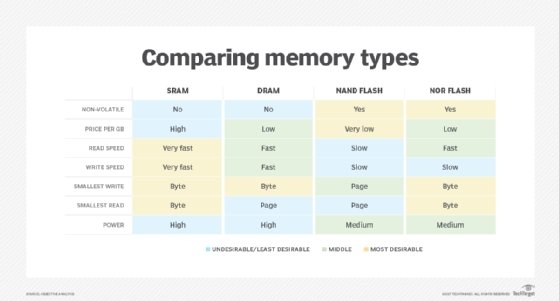RAM-based solid-state drive (SSD)
What is a RAM-based solid-state drive (SSD)?
A RAM-based solid-state drive (SSD) is a storage device made from silicon microchips that has no moving parts and stores data electronically instead of magnetically.
There are two types of SSDs: flash-based and RAM-based. Storage devices based on NAND flash technology represent the majority of SSDs used today. However, NAND flash chips support only a finite number of program/erase cycles and cannot perform as well as RAM memory chips. A RAM-based SSD delivers better performance, while providing greater endurance.
RAM-based SSDs typically use dynamic RAM (DRAM) chips, but sometimes they use static RAM chips. Both types of chips are Volatile, which means that they lose their data when the power is turned off. To preserve the data, it must be copied from the volatile memory to non-volatile memory upon instruction or when the drive is powered down. A RAM-based SSD usually includes batteries to preserve the data long enough for it to be copied to the non-volatile memory, in the event of an unplanned power outage.
The future of RAM-based SSDs
RAM-based devices once dominated the SSD industry. They were often used in financial, telecom, e-commerce and other markets where high latency or downtime were not tolerated. As flash-based SSDs became faster, cheaper and more reliable, they replaced RAM-based SSDs in most commercial and consumer systems.
Despite the proliferation of flash drives, RAM-based SSDs have not disappeared altogether. Although more expensive than their flash-based or electromechanical counterparts, RAM-based drives still offer better performance than other types of storage media, making them well suited for write-intensive workloads. However, these types of SSDs are difficult to find.
One company that continues to offer RAM-based storage is Atto, which introduced its SiliconDisk storage appliance in November 2020. The appliance uses DRAM memory to deliver under 600 nanoseconds of latency, with up to 6.4 million 4K input/output operations per second. The appliance also provides non-volatile memory express over Ethernet connectivity, offering four 100-gigabit Ethernet ports that can deliver 25 gigabytes per second of sustained throughput.
Despite the superior performance of RAM-based SSDs, the storage industry has invested little effort in them, looking instead at other technologies that help bridge the gap between flash-based SSDs and traditional computer memory.
Intel, for example, offers a line of storage class memory (SCM) devices -- the Intel Optane family -- that includes both SSDs and persistent memory modules. Like the SiliconDisk appliance, Optane devices represent a higher tier in the storage hierarchy, sitting between flash SSDs and traditional system memory. However, Optane devices also provide non-volatile storage, without relying on NAND flash technology.

There are also efforts underway to join a computer's memory and storage into a single unit, combining the non-volatility of flash with the performance capabilities of DRAM. This could result in fewer system components and greater application performance. For example, researchers at Lancaster University in England recently published a paper about a new memory technology called UltraRAM, which promises to deliver non-volatile storage with the performance of DRAM, while providing a storage medium that can retain data for over 1,000 years.
UltraRAM and SCM are not the only efforts underway in pursuit of delivering faster, non-volatile storage. Vendors are also pursuing technologies such as magnetoresistive RAM and spin-transfer torque MRAM, which rely on magnetic states for handling data bits. Given these and other efforts, as well as the dynamic nature of the SSD industry, the future of RAM-based storage remains to be seen.







